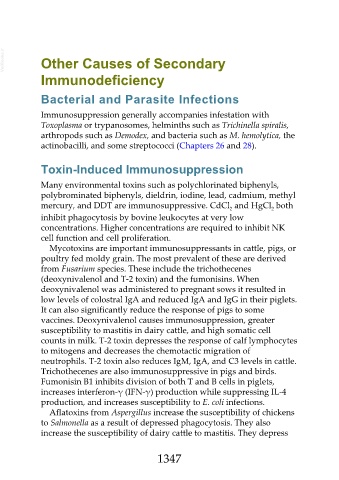Page 1347 - Veterinary Immunology, 10th Edition
P. 1347
VetBooks.ir Other Causes of Secondary
Immunodeficiency
Bacterial and Parasite Infections
Immunosuppression generally accompanies infestation with
Toxoplasma or trypanosomes, helminths such as Trichinella spiralis,
arthropods such as Demodex, and bacteria such as M. hemolytica, the
actinobacilli, and some streptococci (Chapters 26 and 28).
Toxin-Induced Immunosuppression
Many environmental toxins such as polychlorinated biphenyls,
polybrominated biphenyls, dieldrin, iodine, lead, cadmium, methyl
mercury, and DDT are immunosuppressive. CdCl and HgCl both
2 2
inhibit phagocytosis by bovine leukocytes at very low
concentrations. Higher concentrations are required to inhibit NK
cell function and cell proliferation.
Mycotoxins are important immunosuppressants in cattle, pigs, or
poultry fed moldy grain. The most prevalent of these are derived
from Fusarium species. These include the trichothecenes
(deoxynivalenol and T-2 toxin) and the fumonisins. When
deoxynivalenol was administered to pregnant sows it resulted in
low levels of colostral IgA and reduced IgA and IgG in their piglets.
It can also significantly reduce the response of pigs to some
vaccines. Deoxynivalenol causes immunosuppression, greater
susceptibility to mastitis in dairy cattle, and high somatic cell
counts in milk. T-2 toxin depresses the response of calf lymphocytes
to mitogens and decreases the chemotactic migration of
neutrophils. T-2 toxin also reduces IgM, IgA, and C3 levels in cattle.
Trichothecenes are also immunosuppressive in pigs and birds.
Fumonisin B1 inhibits division of both T and B cells in piglets,
increases interferon-γ (IFN-γ) production while suppressing IL-4
production, and increases susceptibility to E. coli infections.
Aflatoxins from Aspergillus increase the susceptibility of chickens
to Salmonella as a result of depressed phagocytosis. They also
increase the susceptibility of dairy cattle to mastitis. They depress
1347

